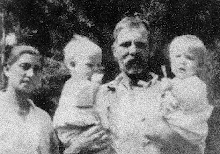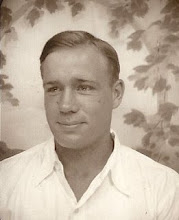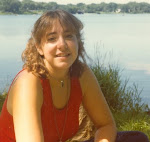Born May 23, 1914
Died January 22, 2005
As written by Joe himself:
In 1910, Edward and Laura Lundgren applied for a homestead in Cass County - Kego Township, in the State of Minnesota. A logging company once used this ground as their headquarters. While there, they made some improvements, such as the log house that was there and the clearing of some brush and trees.
Dad (Edward) and his two oldest children, Emma and Louis, moved [there] with him. Mother (Laura), Art and Loretta came the following spring. Dorothy was born in 1911. It was a cruel country with few white neighbors close by. Wolves and Indians prowling about.
The homestead bordered on Three Island Lake, which took quite a bit of the property. I was the first to be born in the log house on May 3, 1914. I don't remember much during the first few years of my life, but remember well when the twins were born and from then on.
I went to Boe School the first three years and then to Longville through Grade 7. Then we moved in 1927 to another place and I finished at Silver Lake School.
President Roosevelt started the Civilian Conservation Corp in 1933. I was in the first group to leave Cass County to join this program. Like most of the young men, it was the first time away from home for more than a few days.
After a trip to Forst Snelling, where we had our physical and were given new clothes, we were shipped to a campsite close to Bera, Minnesota, under the supervision of an Army Captain. We lived in tents that first summer while more permanent quarters were being built. A small saw mill was set up and we cut our own material. Local carpenters and people on WPA, another government program, built the buildings. This became Camp 708 Bera Minnesota. It was a worthwhile project, as we learned many things and the strict supervision kept most of us out of trouble. We did roadside cleanup, built campsites, fought fires and planted trees in the spring. Along with our work, we had fun playing sports, competing with other camps.
We received $5.00 per month plus food and clothing, $25.00 was sent to the parents. My parents used the money to drill a well. At that time, we were hauling water for home use and the cattle had a long way to go for water.
I was in the CCC for nearly two years - this project was discontinued when World War II started, as all young men were needed in the military. I was inducted into the Army on April 17, 1942, I had my basic training at Camp Robinson, Arkansas. I was sent to Camp Campbell, Kentucky, for further training.
When the hospital was finished, that's where I worked, in one of the wards. This consisted of 20 beds helping an Army Nurse, which was in charge of two wards. It was easy work, taking temperatures, blood pressure, seeing that things were neat and clean. I spent about three months there. Then 16 of us were sent to Camp George G. Mead, Baltimore, Maryland, for further training. I was there for another couple of months and then shipped to Camp Stoneman, CA, for overseas duty.
Approximately 1,800 of us were put on a Norwegian ship. Our first stop was New Caledonia, which was out of the combat zone. A couple of days later we were on the President Jackson ship heading for Guadal Canal. We joined the 23rd Infantry that had been on the island since July, replacing the Marines who made the invasion in December. The ground fighting was over when we arrived, but there were air raids every night and the patrols brought in a few prisoners. The air raids were coming from Munda Air Field on New Georgia Island.
We were sent to New Zealand for a rest cure. Our next combat was in the Phillipines. We covered all of Luzon. We were getting ready for the invasion of Japan when the war ended. I was in the service for three years, six months, and 17 days, serving as a Medical Surgeon Tech. My rank was Tech 3, which is the same grade and pay as a staff Sergeant. In 1946 I returned to Longville.
In September I married Marie A. Kline White, and we left with her son Robert for Oroville, Washington. Our daughter, Susan, was born on February 23, 1947. I worked for Dwinell Brothers in the apple industry. In 1952 we bought a small orchard and sold it in 1968. We moved into Oroville and remained working in the apple business until I retired in 1984. My wife Marie died July 23, 1993. Since July, 1999, I have been lving with my daughter in Ephrata, WA. In May of 2001 we moved to Moses Lake, and live on the lake.
Saturday, April 24, 2010
Joe Emil Lundgren

Email from Leonard Stevens
(married to Lorraine Lundgren Stevens)
JOE EMIL LUNDGREN
May 23, 1914 - January 22, 2005
Joe Lundgren passed away from a heart problem, and this is the passing of a fine, gentleman of the Lundgren family. The love and gentle humor came across visiting and talking on the phone.
Monday, April 12, 2010
What's In A Name
Remembered by Patti Lundgren Franz
April 11, 2010
So, dad told me that he and his twin, Lorraine, were about to be named August and Augusta - until his older sister, Loretta (sixteen years old at the time), exclaimed that they couldn't do that!! And so, they were named Lawrence and Lorraine.
However, it should be noted that their mother, Laura, was fully named Laura Louise Augusta Polsfuss...so the names would have been reasonable.
April 11, 2010
So, dad told me that he and his twin, Lorraine, were about to be named August and Augusta - until his older sister, Loretta (sixteen years old at the time), exclaimed that they couldn't do that!! And so, they were named Lawrence and Lorraine.
However, it should be noted that their mother, Laura, was fully named Laura Louise Augusta Polsfuss...so the names would have been reasonable.
Lundgren Family
Aron Edvard Lundgren
July 20, 1870 - May 23, 1947
Married (on Thanksgiving Day November 24, 1898)
Laura Louise Augusta Polsfuss
August 28, 1882 - October 22, 1955
Together they had these children:
Emma Caroline: August 21, 1899 - December 14, 1979
Louis William: June 9, 1901 - April 29, 1964
Loretta Laura Louise: November 28, 1903 - July 13, 1990
Alfred Otto: 1906 - 1906
Arthur Edward Lundgren: April 12, 1907 - June 3, 1984
Mary: 1909 - 1909
Dorothy Ann: April 10, 1911 - December 15, 1972
Joe Emil: May 23, 1914 - (deceased)
Viola Lidy: May 27, 1979 - December 19,1995
Lawrence Avery: August 13, 1920 - November 16, 2000
Lorraine Avis: August 13, 1920 - (still alive as of this post!)
Jacob Alan: October 16, 1923 - (deceased)
July 20, 1870 - May 23, 1947
Married (on Thanksgiving Day November 24, 1898)
Laura Louise Augusta Polsfuss
August 28, 1882 - October 22, 1955
Together they had these children:
Emma Caroline: August 21, 1899 - December 14, 1979
Louis William: June 9, 1901 - April 29, 1964
Loretta Laura Louise: November 28, 1903 - July 13, 1990
Alfred Otto: 1906 - 1906
Arthur Edward Lundgren: April 12, 1907 - June 3, 1984
Mary: 1909 - 1909
Dorothy Ann: April 10, 1911 - December 15, 1972
Joe Emil: May 23, 1914 - (deceased)
Viola Lidy: May 27, 1979 - December 19,1995
Lawrence Avery: August 13, 1920 - November 16, 2000
Lorraine Avis: August 13, 1920 - (still alive as of this post!)
Jacob Alan: October 16, 1923 - (deceased)
Beginning Of Machinery
By Art Lundgren
Transcribed by Virginia Clawson Freberg
1977
All of the work had to be done by Amy (I don't know who that is) and me - we used scythes to cut hay and more hay until about 1915 when machinery began to be used.
The land we cleared mostly by hand with horses. Some of the luckier ones with money had pullers & had different things to help them, but otherwise there was no machinery until about 1916 when some of the other farmers began to get more machines and hay rakes and one-way ploughs.
Land began to open and they had already dug up the ties and the rails off the railroads for roads. The county and state began to improve the roads a little bit.
People moved in - pretty near every section had a couple people living on it - some of them stayed on the land just a little bit so that they could prove up and get their land for speculation. Others, of course, tried to make a go with all they knew.
Transcribed by Virginia Clawson Freberg
1977
All of the work had to be done by Amy (I don't know who that is) and me - we used scythes to cut hay and more hay until about 1915 when machinery began to be used.
The land we cleared mostly by hand with horses. Some of the luckier ones with money had pullers & had different things to help them, but otherwise there was no machinery until about 1916 when some of the other farmers began to get more machines and hay rakes and one-way ploughs.
Land began to open and they had already dug up the ties and the rails off the railroads for roads. The county and state began to improve the roads a little bit.
People moved in - pretty near every section had a couple people living on it - some of them stayed on the land just a little bit so that they could prove up and get their land for speculation. Others, of course, tried to make a go with all they knew.
The Early Days Up North
By Art Lundgren
Transcribed by Virginia Clawson Freberg
1977
This is Art Lundgren and I'm supposed to talk a little bit, Emma says, about the early days up North (Longville) -- it was really kind of rough. About the turn of the century after the Indians and loggers got moved a little bit, the timber was taken off and the land up there was thrown open to homesteaders and also the railroad land and school land was sold. The Indians were given their choice: they either could keep 80 acres of land or else move further back to the reservation, so that area really became an open reservation with settlers and homesteaders in there.
The people that moved in had it pretty rough. Some of them mostly lived in log cabins and a couple in dug-outs. I know one family lived in a house four years and they did not even have a floor - bare dirt for floor which they kept real clean, while others had their dug-outs.
Later on, after they first built out of logs, some of them were able to find some logs left over from the logging companies who took the most and the best. The floors they put in out of rough pine would wear down so that the knots stuck out.
The cattle they moved up there from the dryer areas mostly became sick; I don't know why they were always sick from the beginning - what we thought was fawn fever. Some of them later got abortion and different things which wasn't too good, and a lot of them died.
Transcribed by Virginia Clawson Freberg
1977
This is Art Lundgren and I'm supposed to talk a little bit, Emma says, about the early days up North (Longville) -- it was really kind of rough. About the turn of the century after the Indians and loggers got moved a little bit, the timber was taken off and the land up there was thrown open to homesteaders and also the railroad land and school land was sold. The Indians were given their choice: they either could keep 80 acres of land or else move further back to the reservation, so that area really became an open reservation with settlers and homesteaders in there.
The people that moved in had it pretty rough. Some of them mostly lived in log cabins and a couple in dug-outs. I know one family lived in a house four years and they did not even have a floor - bare dirt for floor which they kept real clean, while others had their dug-outs.
Later on, after they first built out of logs, some of them were able to find some logs left over from the logging companies who took the most and the best. The floors they put in out of rough pine would wear down so that the knots stuck out.
The cattle they moved up there from the dryer areas mostly became sick; I don't know why they were always sick from the beginning - what we thought was fawn fever. Some of them later got abortion and different things which wasn't too good, and a lot of them died.
Subscribe to:
Posts (Atom)




